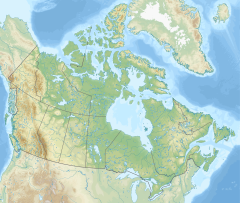| Mount Cromwell | |
|---|---|
 Mt. Cromwell's north face from the Icefields Parkway in 2009 | |
| Highest point | |
| Elevation | 3,380 m (11,090 ft) [1] [2] [a] [b] |
| Prominence | 360 m (1,180 ft) [1] |
| Listing | Mountains of Alberta |
| Coordinates | 52°16′8″N117°23′35″W / 52.26889°N 117.39306°W [2] |
| Geography | |
| Country | Canada |
| Province | Alberta |
| Protected area | Jasper National Park [3] |
| Parent range | Winston Churchill Range [1] [4] |
| Topo map | NTS 83C6 Sunwapta Peak [2] |
| Climbing | |
| First ascent | 1936 |
| Easiest route | rock/snow climb |
Mount Cromwell is a mountain located in the Sunwapta River Valley of Jasper National Park, in Alberta, Canada. Cromwell lies two kilometres north of the east summit of Stutfield Peak. The mountain was named in 1972 by J. Monroe Thorington after Oliver Eaton (Tony) Cromwell, an American climber who made many first ascents in the Canadian Rockies. [3]
Contents
The first ascent was made in 1936 by Oliver E. Cromwell, E. Cromwell jr., Francis S. North, and J. Monroe Thorington. [1] [6] Another source declares the ascent was made in 1938 by the same party but it included the guide Edward Feuz jr [3]
In 2005, Bill Corbett, author of "The 11,000ers of the Canadian Rockies," climbed to the top of Mount Cromwell. At the summit, his GPS registered 11,006 feet. So perhaps Mount Cromwell should be included in the list of the Canadian Rocky Mountains that are over 11,000 feet in elevation. [3]


